
by Roy Carter | Jul 15, 2014

Vegetable Soybean Pods
Image Credit Ann Blount, NFREC, UF IFAS Extension
I am sure you are familiar with soybeans, but probably not in the way we’ll describe it. If you frequently visit health food stores, or the health food section of your supermarket, you’re bound to have seen this vegetable in its dried form. It’s a substitute for meat in many dishes, and it’s used to enhance the nutritional value of numerous foods.
Surprising as it may seem, the soybean is a nutritious and versatile green vegetable. While we’re all fairly familiar with the many uses of dried soybeans, most of us haven’t had much exposure to fresh soybeans. My information was provided by retired Extension Vegetable Specialist Jim Stephens.
There are two main types of soybeans. The one cultivated most frequently is the agronomic or field soybean. It represents 99 percent of all soybeans grown in our country. The second type, which we’re emphasizing, is the vegetable soybean, which is grown for fresh or green mature consumption. The vegetable type is about one-and-a-half to three times larger seeded than the field type.
While few Americans think of soybeans as a vegetable, it has been used as a vegetable in Asia for over 1,000 years. The varieties suitable as a vegetable are different from those used as a field crop. Major vegetable varieties are “Verde”, “Disoy”, “Bansei”, “Gaint Green”, Fuji”, and “Seminole”.
Aside from their good taste and high yield, green soybeans have excellent nutritional value. Fresh soybeans are very high in vitamin c, and they’re also high in protein, containing about three times the protein of milk and about half that of red meat. Fresh soybeans are relatively high in calories, because of their seven percent fat content. Fortunately, this is good quality vegetable fat. Soybeans also contain sizeable amounts of other vitamins and minerals.
As with most fresh vegetables, soybeans should be eaten as soon after harvest as possible. Eating quality and nutrition value begin to decrease within several hours after the beans are picked.
You’ll have an easier time removing the seeds if you place the unshelled beans in boiling water for about three minutes. This will soften the pods, and allow the tender beans to be split out by hand. As a garden-fresh vegetable, soybeans can be prepared like any other fresh shelled beans. Soybean seeds also make excellent bean sprouts.
For more information on edible soybeans contact your county extension office or www.http://edis.ifas.ufl.edu and see Vegetable Gardening in Florida by James M. Stephens, Vegetable Production Handbook for Florida, Vegetable Gardening Guide or IFAS Publication SP 103/VH 021: Florida Vegetable Garden Guide.
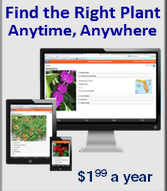
by Mary Salinas | Jul 15, 2014
We all seem to have this dilemma: A desire to re-landscape or just add a few plants to an area, but not knowing what would be the best choice. Plants need to be compatible with their location. The right plant should be chosen for the right place. Many have particular light, moisture and zone requirements in order to do their best. The ultimate size of the plant is also an important consideration; if you want to avoid constant pruning, choose plants that only grow to size you would like to ultimately have. Some great resources are provided below to get you the information you need.
 UF IFAS Extension has a brand new app for your mobile device or web! The app contains a database of over 400 Florida-friendly plants is searchable by plant name, type, shape, native status, light requirements and more. The yearly subscription is only $1.99 to have great info on the go.
UF IFAS Extension has a brand new app for your mobile device or web! The app contains a database of over 400 Florida-friendly plants is searchable by plant name, type, shape, native status, light requirements and more. The yearly subscription is only $1.99 to have great info on the go.
The downloadable 104-page Florida-friendly Landscaping Guide to Landscape Design and Plant Selection not only has photos and detailed information about plants by category, it also has great ideas on how to improve your landscape design! 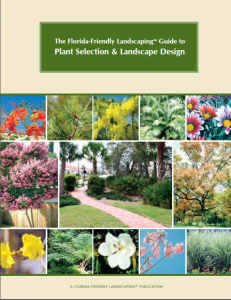
UF’s Florida Yards & Neighborhoods maintains a searchable Florida-friendly Plant Database. Make choices based on region, plant type, light and moisture quantity, soil texture salt tolerance.
For native plants, the Florida Association of Native Nurseries has two websites where you can find plants for your particular zone, plant community (like at the beach or in pine flatwoods), plant type and by wildlife usage. There is a site designed for nursery professionals that lets you find local wholesale growers and also a similar site for homeowners that has resources on where to find desired plants at local nurseries.
Speaking of native plants, the Florida Native Plant Society also has a searchable list of plants appropriate for your particular needs.
Gardening Solutions has lots of great information for lawn, landscape and garden by category, and it is easily accessed.
Happy Gardening!
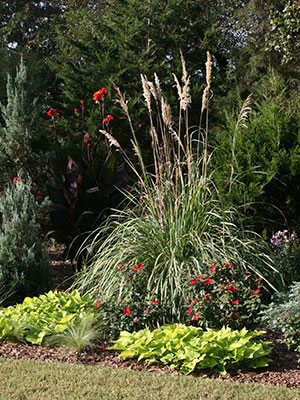
by Roy Carter | Jul 8, 2014
 You don’t have to pamper pampas grass! This attractive perennial, which is native to Latin America – Brazil, Argentina, and Chile, is practically trouble-free. It’s well adapted to all areas of Florida. Pampas grass grows in large clumps, eight to ten feet high. In late summer, it produces showy silver –white or pinkish silken plumes, which may reach a height of 12 feet.
You don’t have to pamper pampas grass! This attractive perennial, which is native to Latin America – Brazil, Argentina, and Chile, is practically trouble-free. It’s well adapted to all areas of Florida. Pampas grass grows in large clumps, eight to ten feet high. In late summer, it produces showy silver –white or pinkish silken plumes, which may reach a height of 12 feet.
Pampas grass can be very eye-catching when used as a specimen plant in the landscape. Since it grows very rapidly into a massive plant, pampas grass can provide an excellent screen for sunny locations. Unfortunately, it is often used improperly as a foundation plant. In such cases, it usually is purchased from a nursery when it’s small and planted very near the home. At first, it will look fine, but, after several years, it will have reached such a large size that it will be difficult to find the house for the old pampas grass.
“This vigorous ornamental grass is widely used as a lawn specimen but its quick growth rate and large size make it unsuitable for all but large home landscapes. However, it is ideal for barrier or windbreak plantings and has a place in larger areas such as along highways or in commercial or industrial landscapes.” FPS145
There are many ornamental forms of pampas grass. The plum-like blooms differ between male and female plants. The female plumes are broad and full, due to the silky hairs covering the tiny flowers. The male plumes look narrow and short, because of the absence of hair on the flowers. Also, there is considerable variation among seedlings in growth habit, period of flowering, and size and shape of plumes. If uniformity is desired, pampas grass should be propagated by dividing clumps, rather than by seed.
The plumes of pampas grass are highly prized for indoor decorations. Plumes used for this purpose should be cut as soon as they have fully emerged. If mature plumes are brought indoors, they will fill the home with delicate fluffy flowers which can be a bigger problem than a shedding dog or cat. This shedding can be prevented by spraying mature plumes with hair spray.
When selecting planting site for pampas grass, special attention should be paid to the potential danger or injury to passersby from contact with the very sharp, saw-like edges of the leaves. Pampas grass should be planted where it will receive full sun for most of the day. In shady locations, it will grow very slowly and produce few, if any, plumes.
Pampas grass suffers from practically no pest or disease problems. It has good salt tolerance, and will grow in almost any soil. Once it’s established, about all you need to do is give it adequate fertilizer. For healthy growth and good plume production, pampas grass should be fertilized four times a year with a balanced fertilizer, such as an 8-8-8, applied at the rate of two pounds per 100 square feet.
In North Florida, pampas grass leaves are often killed by freezing temperatures. But, new leaves will sprout in the spring. Before spring growth begins, you should prune away brown leaves and other dead material that has accumulated at the base of your plants. When working around pampas grass, it’s a good ideas to wear long pants, a longs sleeve shirt, and gloves to protect you from the sharp leaf blades mentioned earlier.
The striking, feathery plumes and large, graceful clumps of foliage make pampas grass a very desirable addition to a landscape. Since it so trouble-free, perhaps you’d like to try some around your home.
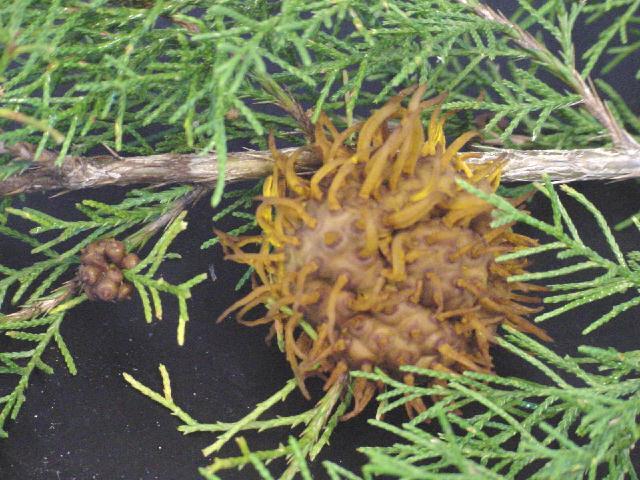
by Matthew Orwat | Jul 8, 2014
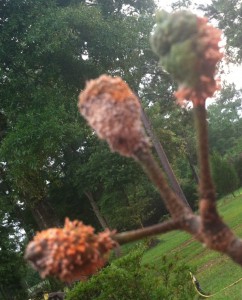
Cedar-Apple rust or Cedar-Quince rust (Gymnosporangium) symptoms on pear fruit. Image Credit Shep Eubanks, UF IFAS.
This is the season for fruit harvesting, particularly for those fruits in the rose family such as plum, quince, peach, pear and apple. Many avid home horticulturists have been enjoying the fruits of their labor, but some have been thwarted by an unlikely and ugly disease.
This fungal disorder, commonly called cedar-apple rust and caused by various species of Gymnosporangium, has the potential to ruin Quince, Pear and Apple crops in gardens throughout Northwest Florida. Early scouting and vigilance will pay off.
This condition begins on native juniper species (known as cedars). A spore producing gall forms on the branches of the cedar tree, which begin to produce spores during wet weather. Spores, once produced, can travel up to a mile via wind. If spores land on susceptible plant tissue when a film of water is present, it will germinate and infect the fruit, twig or leaf. Although black spots develop on the plant with in 7-10 days of infection, orange tubes called aecia won’t develop until 4 or more weeks after infection. Next, spores are released from the aecia located on the fruit tree and travel to infect new juniper plants . The infected junipers will not show symptoms until the next growing season but they can manifest as galls or orange ooze present under bark. Different species of Gymnosporangium will infect trees differently. Some live only for one year while others, known as ceder-quince rusts, can last up to 20 years. Twigs infected with this disease usually die within several years of infection.
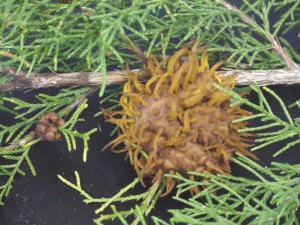
Ceder-Apple Rust on infected juniper host species. Image Credit Hank Dankers UF IFAS.
Although this may seem like an impossible situation, several control strategies exist.
- Remove Infected branches: Removal of infected plant tissue will reduce the spread of the disease in your garden.
- Removal of infected juniper host species: If the juniper or “cedar” in your landscape is something you can sacrifice, removal is warranted in cases of heavy infection.
- Avoid planting susceptible species of juniper next to susceptible fruit tree species.
- Treatment of fruit trees with fungicide: Preventative fungicidal sprays of products containing the active ingredients of sulfur, captan, chlorothalonil, or mancozeb and similar products can be effective. They will not cure existing conditions but are useful if you know that rusts are present in your area. Please read all pesticide labels before application, since there are pre-harvest limitations present on some products.
For additional information, please consult you local county extension office or review these publications by UF IFAS specialists (Florida Plant Disease Management Guide) and the Missouri Botanical Garden.
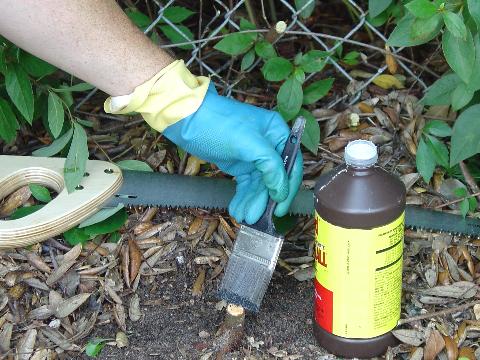
by Larry Williams | Jul 8, 2014
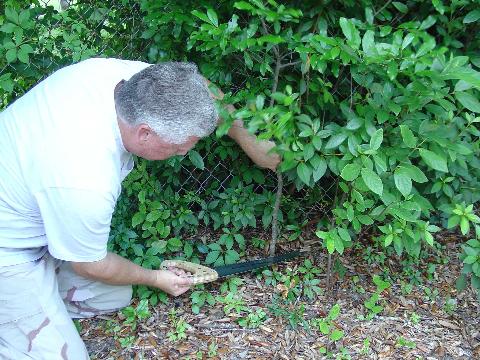
Making cut before herbicide application Photo Credits: Larry Williams & Sheila Dunning, Okaloosa County Extension Agents
Question: We planted Wisteria for its beautiful spring flowers and it grew and grew and took over everything. Now we’re trying to get rid of it. New plants are sprouting everywhere – up to ten feet away from the original plant. Is there a way to rid our landscape of this now wild plant?
Answer: Chinese Wisteria, Wisteria sinensis, can be a big problem to control. I’ve seen entire fields taken over by it. Yet, many people wonder why you would want to kill a beautiful plant like Wisteria. It’s possible to keep it in bounds for a while (possibly years) in the middle of a lawn with its new shoots arising from roots being routinely mowed. But in many cases, given enough time, shoots coming from roots will escape and then begin to take over – growing on adjacent property, climbing trees, etc.

Application of triclopyr herbicide to cut stump Photo Credits: Larry Williams & Sheila Dunning, Okaloosa County Extension Agents
In order to control an established vine, you must be persistent. Your best bet, outside of moving, is to use a “cut stump” treatment on the main plant and every shoot that sprouts. Use a herbicide that contains triclopyr. Some brand names include Enforcer Brush Killer, Ortho Brush-B-Gon, Ferti-lome Brush Killer-Stump Killer. Cut the main stem (trunk) as close to the ground as possible and as level as possible to facilitate application of the herbicide to prevent sprouting. It is critical to immediately apply the product to the freshly cut “stump.” Stumps that are not treated with the herbicide will sprout. Always follow label directions and precautions and be very careful to not get the product on adjacent desirable plants, including their roots.
Other invasive, undesirable woody plants can be controlled using this method such as Chinese tallow (popcorn tree), Chinese privet (Ligustrum sinensis) and Japanese honeysuckle (Lonicera japonica). For more information, view “Herbicide Techniques for Woody Plant Control”, from UF IFAS Extension .









